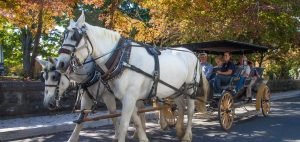Written by SK Stahling, Esq.
Edited by Bill Pfund, Esq.
You may remember that KPM’s own Bill Pfund authored this article in March 2017 discussing Virginia’s Equine Liability Act, § 3.2-6200 et seq. At that time, very few Virginia courts had analyzed the breadth or scope of the Act. Earlier this summer, Rockbridge Circuit Court applied the Act in Paz v. Layman and determined that the scope of immunity may not be as broad as the General Assembly intended.

No copyright infringement intended. For more information, visit LexingtonVirginia.com
To recap, the Virginia Equine Liability Act says that no person shall be liable for an injury to or the death of another resulting from the intrinsic dangers of equine activities and that no participant shall have a claim against another person for injury or death of the participant resulting from these intrinsic dangers. The Act goes on to define those things which are included “equine activity” – this list includes “rides, trips, hunts, or other equine activities of any type however informal or impromptu that are sponsored by an equine activity sponsor,” which could arguably include horse-drawn carriage rides. Important to the most recent opinion, the Act further defines an “equine activity sponsor” as “any person or his agent who, for profit or not for profit, sponsors, organizes, or provides the facilities for an equine activity . . . and operators, instructors, and promoters of equine facilities, including stables, clubhouses, ponyride strings, fairs, and arenas where the activity is held.”
In Paz v. Layman, the plaintiffs allege personal injury as a result of a carriage trip gone haywire. Allegedly, an employee of the Virginia Horse & Carriage Co., which operates historic rides through Lexington, Virginia, lost control of the horses and fell out of carriage. After the driver fell out, the horses apparently went wild and the carriage hit a curb, flipped over, and ejected the passengers. Paz and another passenger then sued the carriage driver and company, who filed Motions for Summary Judgment based on the Equine Liability Act.
The plaintiffs argued that the carriage company did not meet the Act’s definition of “equine event sponsor” and therefore, was not shielded from liability.
Judge Anita Filson agreed with the plaintiff and went one step further. In addition to agreeing that the carriage company was not an “equine activity sponsor,” she found that the plaintiffs were not “participants” since they did not engage in an equine activity.
This case reinforces the general trend in Virginia circuit courts that judges are reluctant to take issues away from a jury. More specific to this case, apparently the scope of the Equine Liability Act may not be as black and white as the General Assembly thought it was and this issue could be a good point for appeal or revision from the legislature. Never fear, your attorneys at KPM will continue to follow this issue and keep you informed of any changes to the case law or statute.
